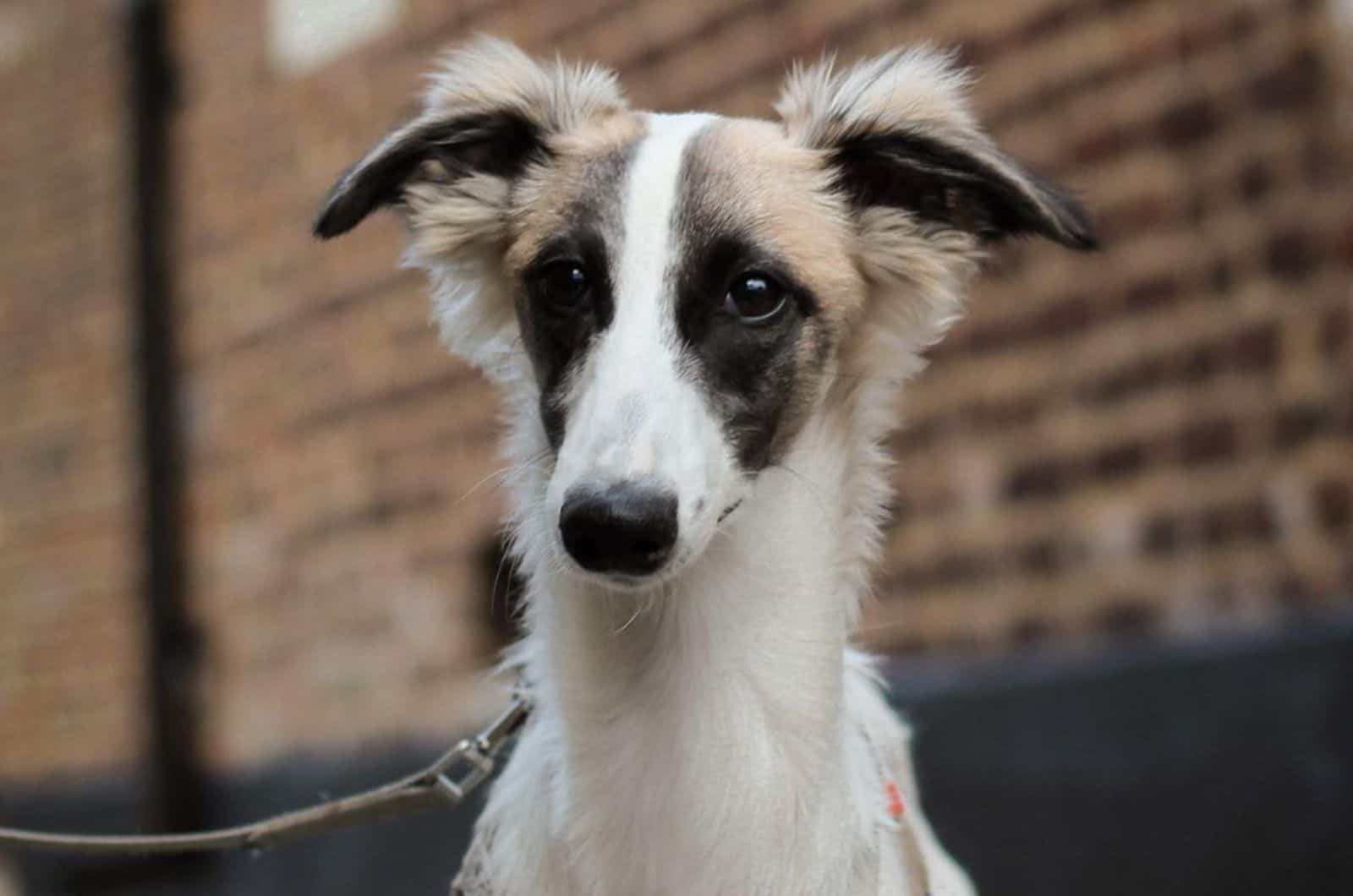The Long haired Whippet is particularly distinctive from the Whippet breed, which typically has short, straight hair because it is so lovely, soft, and silky.
They were just created roughly 50 years ago, making them a new breed in the world of dogs. The debate over whether dogs are considered to be pure breeds or not continues to this day.
Despite this, the Longhaired Whippet is still around and has become popular due to its graceful and affectionate nature. This dog is as athletic as they come and enjoys playing and running.
They are nice and well-behaved animals that make amusing playmates for kids. This dog’s long coat may keep him warm in chilly weather (however, you will probably have to buy a few sweaters or jackets for this dog if you’re living in a colder area), and it is surprisingly simple to keep clean.
The Long haired Whippet enjoys doing its owner’s bidding, and this dog is eager to learn. This isn’t the type of dog to leave outside and forget since they are very people-oriented and will desire to be together with their human family.
What Is A Long Haired Whippet?
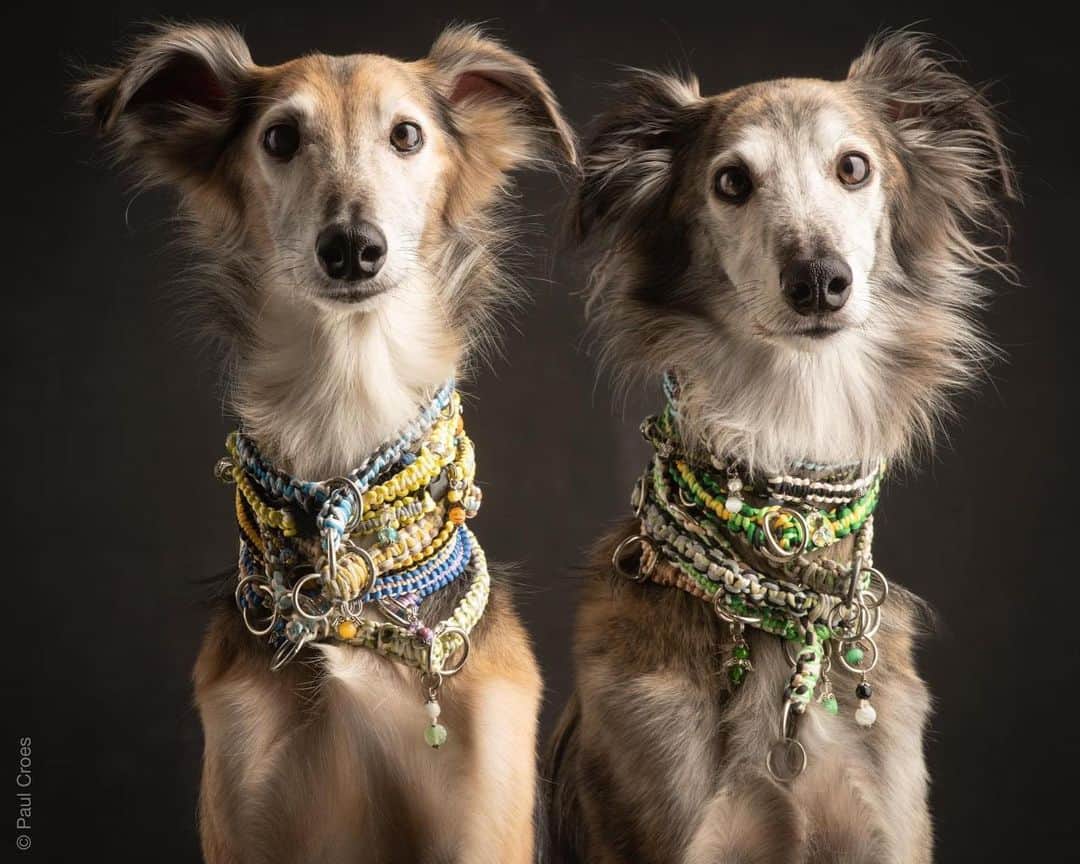
By activating a hereditary long hair trait present in purebred Whippets, Walter Wheeler, an American Whippet producer, was reported to have created a long haired variant of the Whippet in the 1980s.
While it is true that Whippets, as well as Greyhounds (which is a Whippet progenitor), share a recessive fine long hair gene, Wheeler’s claim that he had invented a brand-new pure dog breed became highly challenged.
There was a widespread misconception that Wheeler had mixed purebred Whippets with long-haired purebred dogs such as Shetland Sheepdogs.
Studies have shown that the Longhaired Whippet has a recessive gene that is absent in Whippets but present in Shetland Sheepdogs. This is evidence in favor of the theory that the long-haired variation is a Whippet mix rather than a distinct breed.
The debate over whether the Longhaired Whippet can be a purebred or a crossbreed is still going on. As of right now, neither the American Whippet Club nor the American Kennel Club recognize the Longhaired Whippet as more of a distinct breed.
The Longhaired Whippet, at some point, underwent a sort of rebranding, adopting the rather fancier moniker of the Silken Windsprite / or the Silken Windhound. Also, a Silken Windsprite Club was formed. Perhaps the intention was to distance the Whippet association from the name.
The Windsprite term has been widely used in the US since 2017, and a club was formed named the International Windsprite Club. However, Longhaired Whippet usage is still widespread in Europe today.
Read more: The Top 40 Shetland Sheepdog mixes
How Do People Refer To The Long Haired Whippet?
A Long Haired Whippet is a breed of smooth coat, medium-sized sighthound, which also includes the Greyhound, Saluki, Afghan Hound, Borzoi, Pharaoh Hound, as well as the Irish Wolfhound.
In its early years, the Whippet breed went under colorful names like “Poor Man’s Racehorse” and “Lightning Rag Dog”.
They were given these nicknames, because the dogs participating in the race would be chasing a cloth that was dragged through the straight course of the race track.
The term “whappet,” an old word that means “a little dog that yaps,” appears to be the source of the name Whippet.
Which Two Breeds Make Up A Whippet?
Developed in England in the middle of the 19th century, the whippet is a type of hound used for competitive arena rabbit chasing. Small English Greyhounds and terriers were used to create the breed; subsequently, Italian greyhounds were mixed in to provide the whippet with a smooth look.
The origins of the Longhaired Whippet proceeded to be hotly contested. When he specifically bred his personal pups with some other Whippet breeders that showed scientific proof of harboring the longhaired gene, Walter A. Wheeler Jr. reported to be victorious in the 1970s.
Others think he must have mixed the dogs with certain other breeds like the Borzoi or perhaps the Shetland Sheepdog, both of which Wheeler had, even though he swore they were only descended from Shorthaired Whippet stock.
Origin Of This Dog Breed
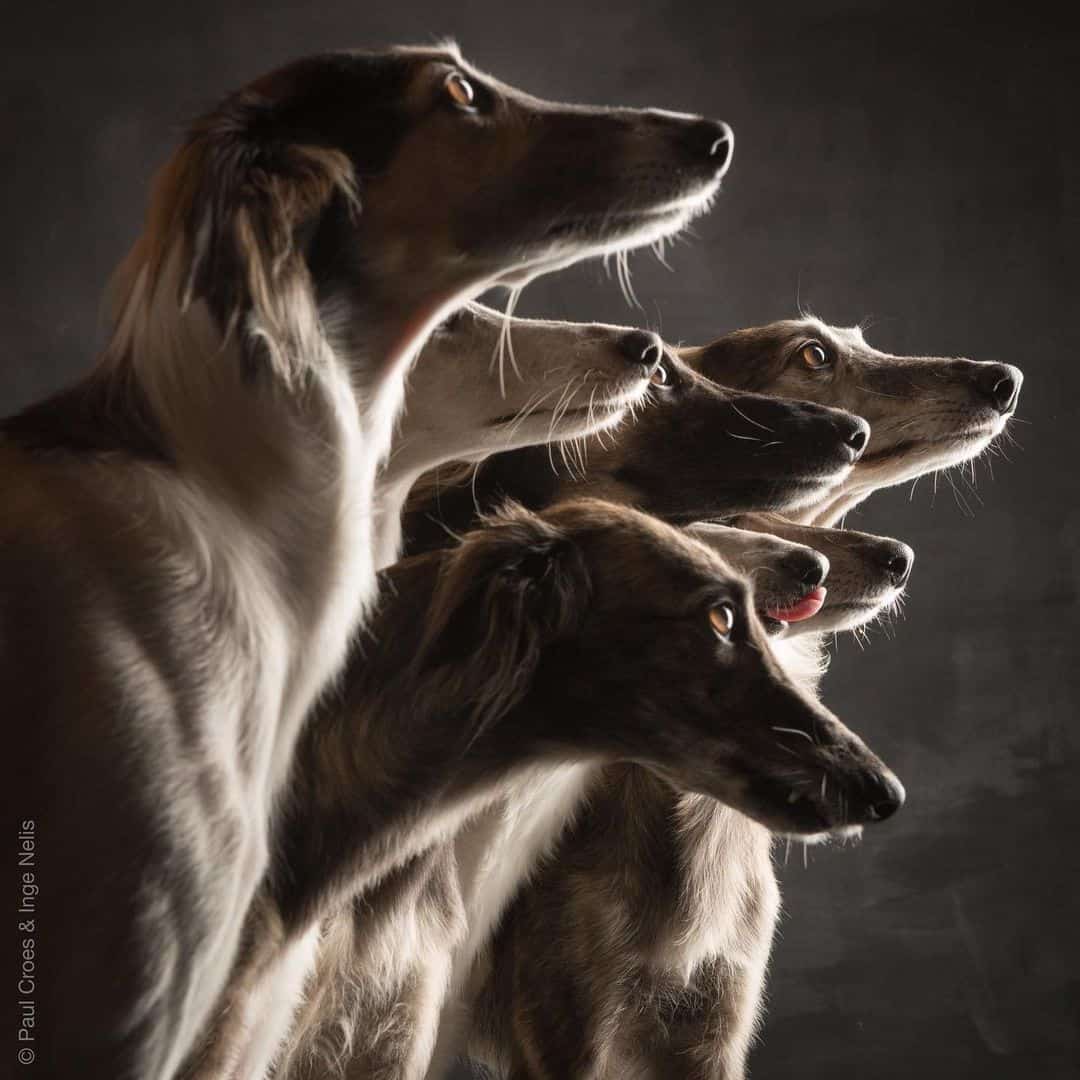
The Whippet is a well-behaved member of this family of lightning-quick sprinters, while the Greyhound served as the model for later sighthounds for thousands of years.
The history of The Whippet starts in Victorian England. On their time off, the coal workers in the northwest preferred rabbit hunts and dog racing.
The Longhaired Whippet‘s evolution is still a topic of contention. In the 1970s, Walter A. Wheeler Jr., a Whippet breeder, claimed to have achieved success by selectively breeding his own pups with Whippets from other breeders who showed outward signs of having the longhaired gene.
Others think he must have mixed his dogs with some other breeds, including the Borzoi or perhaps the Shetland Sheepdog, both of which Wheeler had, even though he claimed they were only descended from Shorthaired Whippet blood.
Since the Shorthaired Whippet is the original standard dog, many breeders contend that the term Whippet should solely be applied to that breed. There was also a breed of Whippets with rough coats, but they tragically went extinct in 1957.
While there is ongoing discussion over the benefits and drawbacks of the unusual hereditary longer coat gene or indeed the recessive MDR1 mutation that have affected the breed, the Longhaired Whippet has become an established breed.
They are becoming more and more well-liked among dog lovers all over the world thanks to their sweet personalities and stunning appearance.
The Longhaired Whippet, now recognized as the Silken Windsprite, was developed by Francie Stull, a different breeder, by mating Borzoi dogs with Longhaired Whippets that came from Walter A. Wheeler’s kennels.
The Silken Windsprite is somewhat smaller than the Longhaired Whippet despite the two breeds being almost indistinguishable.
AKC And The Long Haired Whippet
In 1888, the American Kennel Club (AKC) registered its first Whippet, yet the Longhaired cousin has still not officially been made a purebred dog breed. Nowadays, lure coursing is a fantastic way to satisfy the Whippet’s demand for speed.
The Longhaired Whippet is really not acknowledged as a separate breed by the prominent kennel clubs, despite the existence of two clubs dedicated to the breed: the International Longhaired Whippet Club as well as the Longhaired Whippet Association.
Both organizations strive to provide conformation and performance occasions for their members to use in promoting this magnificent breed.
The Whippet was an instant hit in America, and just like in England, Whippet racing—whether for money or for pure enjoyment—became popular with people from different walks of life.
What Does A Long Haired Whippet Look Like?

Both the Longhaired Whippet and the purebred Whippet are medium-sized dogs. Its height ranges from 16 to 22 inches, and its weight ranges from 20 to 35 pounds. Generally speaking, females are smaller than males.
Purebred Whippets and Longhaired Whippets have very comparable physical characteristics. They both belong to medium-sized dog breeds, share a long neck, a deep chest, and a small waist, and are both extremely quick runners.
Their coats are the main visual distinction between the two breeds.
While the long-haired type of the Whippet has a coat that is lengthy and wavy, purebred Whippets have quite a short, silky coat (silken).
When in reality, the two breeds are rather close in size, this gives the Longhaired Whippet the appearance of being the bigger of the two.
Looking More Deeply Into Bodily Characteristics
It is important when buying a dog breed to know some of the healthy bodily characteristics; therefore, you may know if your dog looks healthy.
Because of that, I have decided to introduce some of the most important bodily characteristics of your Long Haired Whippet.
Head Of The Long Haired Whippet
Whippets have a dolichocephalic skull type, which means that it is proportionate to the rest of the body and somewhat long. The top skull appears long, but despite this, it is also suitably broad between both ears, providing the head with some solidity and preventing a slender, snippy impression.
When seen in front or from a profile, the top skull has a flat top. From the large rear cranium to the nose, the head considerably narrows. The head is smooth and free of wrinkles or extra skin.
Facial Features
Eyes: Medium-sized, oval to nearly round eyes that are either medium or dark brown in hue or dark gray, amber, or hazel in color. Well-fitting and well-pigmented eye rims are present.
Never do the eyeballs swell outward. The orbital sockets that surround the eyes should have enough bone to shield them. Any entropion or ectropion symptoms are inappropriate for this breed.
Ears: Small to medium-sized, positioned at or above eye level on the skull, and either rose or “fly-away.” Never are the ears lengthy, very big, hound-like, or totally upright.
Muzzle: The snout is long, thick, deep, extremely broad, and whether seen in perspective or from above, it just slightly tapers toward the muzzle. The muzzle’s plane, also known as the bridge, is straight.
The lower and upper jaws are equally long, well-developed, and also have good bone structure; they never appear snippy or frail.
Nose: Depending on the coat, the nose may be well-pigmented black. Butterfly noses with several colors are OK. Well-opened nostrils are present. The nose may lay level with the lower jaw or protrude slightly forward beyond it.
Body
Tail: As a logical continuation of the gracefully arched topline, it should be set lower on the croup. It has a thick base and a point that tapers.
When running or chasing, the tails are carried according to the dog’s disposition and degree of energy; it is typically at or below the topline and in a lower stable position whenever the dog is relaxed, although it is never folded against by the abdomen.
The tail can seem tucked when placed neutrally because of the size of the tail and the angle of the rear legs, yet this is a normal neutral state for the Whippet. Never is the tail carried significantly above the topline.
When held down, the tip of the final vertebrae of the tail extends to the hock joints, giving it a considerable length. Either a straight or mildly curled tail is possible.
Chest: Never wider than deep, but deep enough to fill the area between the forelegs and minimize a hollowed effect. The brisket is very lengthy, reaching the elbows’ points.
Body: Deeper in the chest, supple, athletic, strong, and able to move with exceptional speed, power, and endurance. The body is strong if a little racy. The width of the forequarters is almost equivalent to the width of the hindquarters.
Coat Colors Of A Long Haired Whippet
“Any color or combination of colors” is allowed for longhaired whippets. That is mostly accurate. The Whippet is available in a huge range of colors and marking styles. Among the base hues are beige, red, peach, tan, white, black, and blue.
We can always look at the usual Whippet colors in order to have something that we can rely on when searching for our desired long hair Whippet coat color.
There are several different types of markings, from completely white to merely the tips of the toes and tail, including brindle of black stripes, brindle and blueish striping, watermarking, as well as sabling.
Although “ticking,” or a scattering of black or fawn/red specks inside the marked white areas, may be present in white markings, these should never resemble Dalmatian-style “spots.”
Rarer even, a fawn or brindle base with a black or blue saddle covering it gives the impression of being bicolor or tricolor.
Also observed are various spots, blazes, and patches—sometimes all within the same litter!
This breed’s coloring varies; hues include black, red, brindle, fawn, and brown, all accented with hints of white. The Longhaired Whippet has outstanding beauty and a lovely temperament.
What Kind Of A Personality Does The Long Haired Whippet Have?
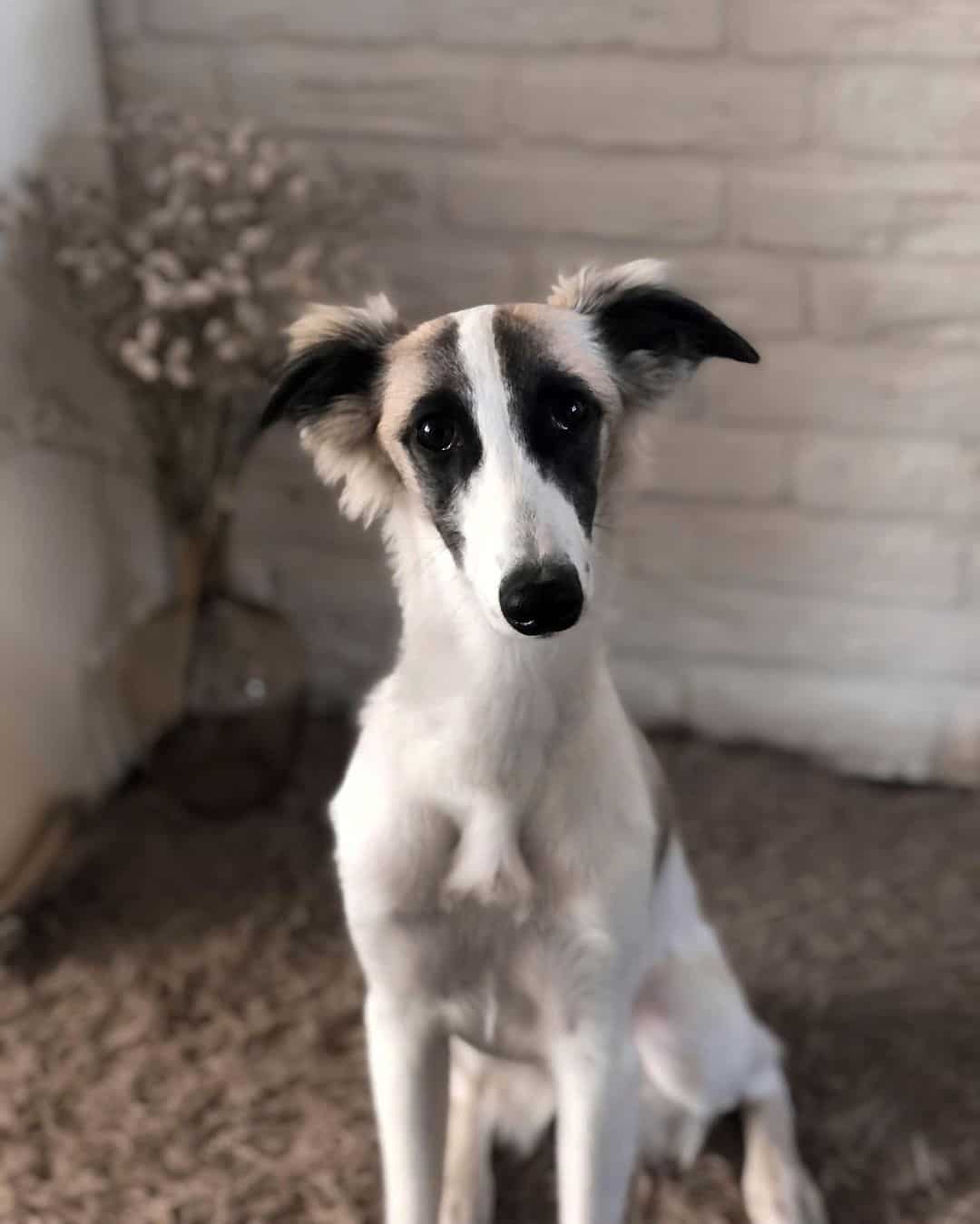
Whippets with long hair are renowned for being gentle, affectionate canines. They are also playful and love playing games, particularly those that entail chasing after an object.
A dog that enjoys chasing other animals around the house might be a lot of fun, but you must exercise caution if you also have other creatures in the house. Longhaired Whippets are Sighthounds, just like purebred Whippets, and they possess a powerful prey drive.
Whippets have exceptional temperaments; they are affable, affectionate, and laid-back. They are claimed to be canines that are particularly perceptive to their masters’ moods and will act accordingly.
They do enjoy a good chase, though, so if a Whippet isn’t on its leash, other little, fluffy animals might be in danger! Because they are still sighthounds, they will naturally pursue moving objects.
This implies that your puppy must learn the fundamentals of obedience. Beginning at an early age, a puppy can be taught NOT to chase or to be called off a pursuit and to return right away when called.
Whippets are friendly with people, simple to housebreak, and appreciate living with the family in the home.
As a result, you would have to put in a lot of effort to train the Longhaired Whippet to overcome this propensity, but you might find that it’s difficult because it’s ingrained throughout all Sighthound breeds.
If they aren’t properly socialized, all dogs have the potential to be aloof. Longhaired Whippets make wonderful family pets and are friendly around familiar faces. It’s crucial to give your dog instruction to support them if you want to guarantee their happiness and confidence.
This cute dog will enjoy hikes since it has an athletic body. They like being active, and they are amongst the dog breeds which need a significant amount of daily activities. But more about that later!
Are They Good Family Dogs?
The breed specializes in sports akin to lure coursing, agility, and racing. The Longhaired Whippet enjoys playing with kids and is not beyond having a little fun.
Whenever they choose to perform, they behave like a clown, running and twirling around the children. They adore being part of family activities, everyday outings, and walks, among other activities.
Additionally, they have a peaceful interior and are content to cuddle up with you or sleep close by. Daily exercise is crucial, as it is for the majority of dogs, but you should also incorporate training and some mental exercises.
Training requires less time with them than with some other breeds because they are eager to learn and particularly good at taking direction.
These dogs like being around their human family, and they like spending time doing various activities together. When it comes to them being family dogs, they seem to be an excellent choice for families who enjoy various activities.
Is The Long Haired Whippet A Healthy Dog Breed?
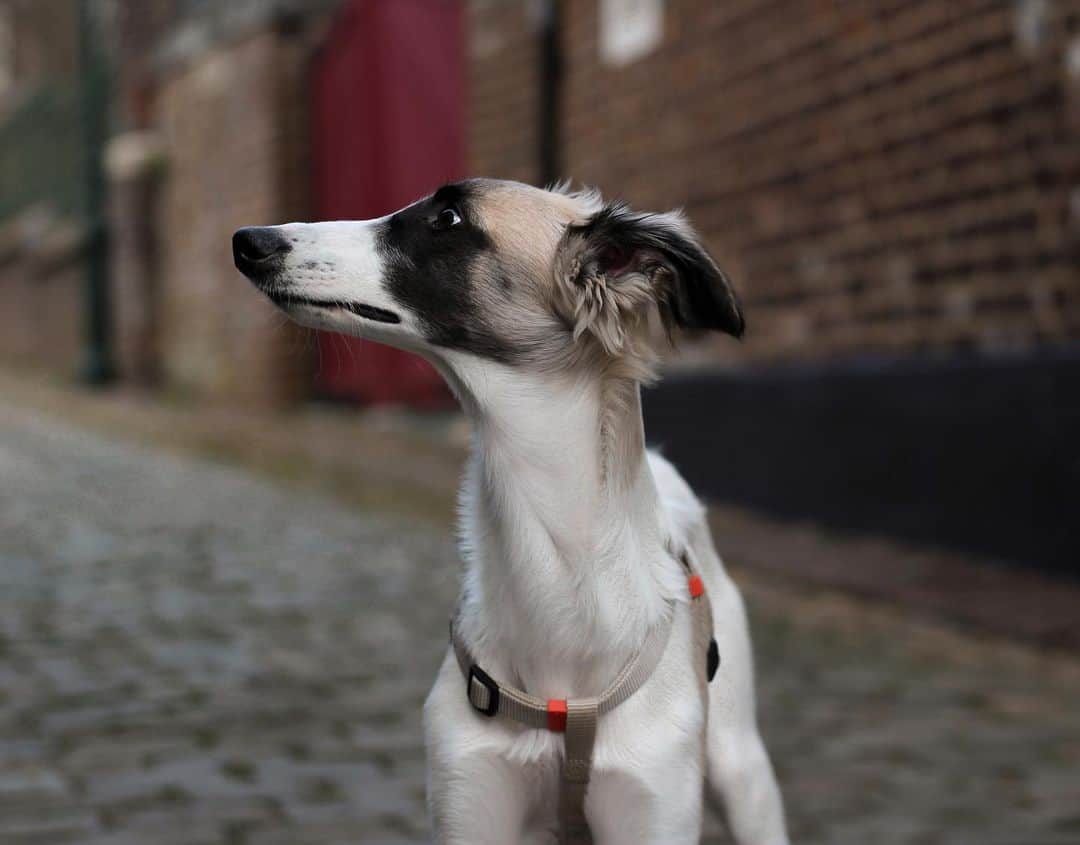
Due to their Whippet heritage, Silken Windsprites have a sturdy build and are less likely than other breeds to experience health problems, including hip dysplasia and intestinal disorders.
They have quite a long lifespan of 12 to 15 years, and provided they don’t overeat and get enough activity each day, they should live long, healthy lives.
As with any other dog breed, this one also has some possible health issues that owners have to keep an eye on.
Possible Health Issues Of A Long Haired Whippet
You should request a copy of the test results from a respectable breeder who will test for those. Obtain a duplicate of the veterinarian wellness examination if you are adopting your dog.
It’s beneficial to have knowledge of some of these difficulties so you can contribute to the healthiest possible care for your Long Haired Whippet puppy.
Some of the possible health issues that may affect Whippet health are:
1. Blindness
Whippets may develop tiny white mineral formations in their corneas due to a disorder known as corneal dystrophy.
It advances gradually and causes no pain. Sadly, there is no cure to get rid of these deposits.
Another issue is the hereditary condition known as gradual retinal atrophy, which renders dogs blind.
Similar to corneal dystrophy, this condition doesn’t hurt, but there is no cure. With a few adjustments, your Whippet can still have a life that is relatively normal.
2. Thyroid Issues
The thyroid gland’s underproduction is what leads to hypothyroidism. The metabolism of a dog is regulated by this gland.
Consequently, dogs with this ailment might have a variety of signs and symptoms, such as hair loss, appetite loss or thirst, and drowsiness.
Patients with afflicted dogs must start taking hormone replacement therapy after being diagnosed by blood tests.
The majority of dogs will require daily administration of this drug for the remainder of their lives. Fortunately, if treated, hypothyroidism has little impact on dogs.
3. Deafness
Whippets are incredibly resilient dogs that rarely suffer from the majority of canine diseases. Nevertheless, they are still prone to ailments that could develop with aging, such as hearing.
Whippets may lose their hearing permanently as they age or may be born deaf. Over time, you can notice your dog growing more unresponsive.
If your dog has the disease, you’ll need to modify your lifestyle to make room for your new family member. Due to their increased susceptibility to being startled, deaf dogs should only be approached carefully.
Additionally, you must always have your dog on a leash because, when out in the open, they won’t be able to hear your instructions.
Read more about deafness in dogs.
4. Vestibular Disease
Dogs with vestibular dysfunction experience abrupt loss of coordination and orientation. Even though it affects Whippets on a fairly regular basis, there is no one cause for this illness.
It could be brought on by aging, an ear infection, or physical trauma. Within 48 hours, the majority of dogs are capable of recovering from dizzy episodes. Rarely, affected dogs may exhibit head tilt or chronic “wobbling.”
Fortunately, Whippets have a reputation for being generally quite healthy dogs. So that you can properly care for your canine companion, it’s a good idea to learn the most prevalent health issues that they encounter. The time you spend with your swift sweetie will be enjoyable.
5. Heart Problems
The incapability of the heart to adequately pump blood to the body is referred to as cardiovascular or heart illness in dogs.
This condition’s most prevalent kind is brought on by a leaking heart valve or a heart rhythm problem. Your Whippet may start coughing frequently or experience respiratory problems.
Over time, dogs with this illness will become more easily exhausted. Other signs include pale-blue gums, an increase in belly size, or loss of appetite.
An ECG, blood tests, and X-rays are frequently used to diagnose heart problems. Fortunately, there are several drugs available to assist your dog in gradually controlling their heart issue.
Healthy Movement Looks Like:
The qualities of a healthy structure seem apparent: when shifting away, the forelegs, as well as rear pasterns, must remain parallel to each other. Flexible, easy, smooth, effective, also with lots of energy.
The forelegs must remain parallel while seeing movements from the front, with both the elbows and paws remaining immobile. When the back legs are stretched, the rear pads ought to be seen from behind.
The forelimbs, as well as hind limbs, may approach the center of mass as speed increases. The top line should look sturdy and level from the side. The forepaw can stretch out into a line also with the nose when there is a good range of motion in the front.
In order to demonstrate stability, excellent reach, and adequate power, the distance between the stretched forefeet and hindfeet should be roughly equal.
Any canine showing signs of respiratory problems or locomotive issues will be evident if they are not following the above-mentioned healthy movements.
Maintaining A Long Haired Whippet
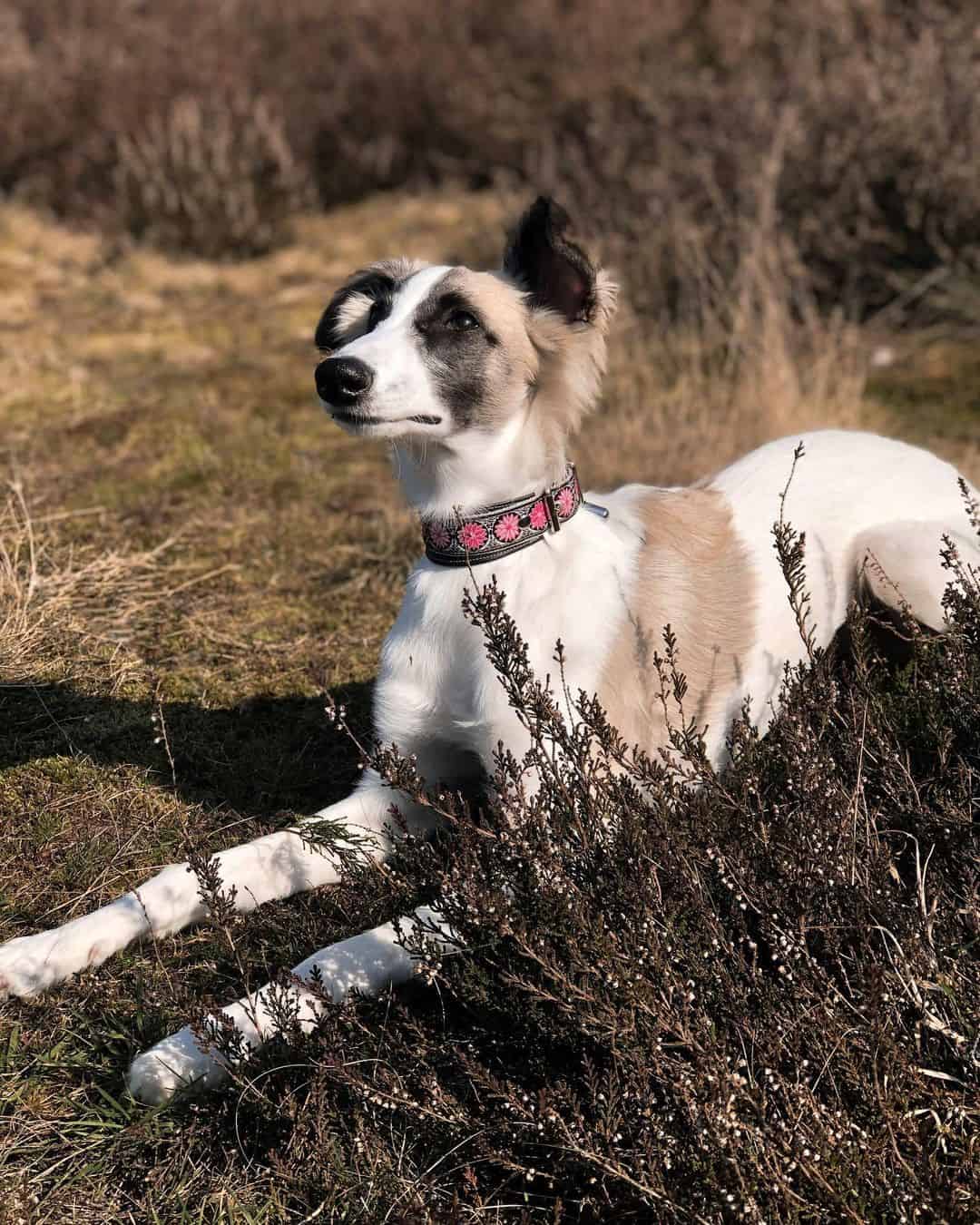
Given their low maintenance grooming requirements and general good health, Whippet dogs are a laid-back and manageable breed.
Although they don’t like the cold in the literal sense, they don’t do well in it metaphorically either, so you might find yourself purchasing dog outfits of coats and jumpers rather than stockpiling on maintenance products.
One issue about which they don’t appear at ease? Their drive to run. Due to their high energy levels, Long haired Whippets require a lot of opportunities for exercising and stretching their legs.
Grooming Needs
They resemble cats in that they enjoy keeping themselves tidy. All that is necessary is routine toenail trimming, dental hygiene, and the odd bath or wipe down. They make the best house pets since they are naturally tidy dogs.
They have a lovely, silky coat, which minimally sheds and is hypoallergenic. When minimal shedding occurs, a short brush through will remove the majority of the loose hair, and you should be done in no time.
Whippets do shed occasionally, but they have a very short and low-maintenance coat. “The whippet has the benefit of requiring less grooming. With all of that kind of coat, they’re sort of machine-washable. (Just kidding!)
In addition, long-haired Whippets don’t retain moisture in their ears as some other breeds do, have very little “doggy odor,” and don’t require frequent bathing.
After a frolic outside, vets suggest trimming their nails shorter and cleaning them down. Their coats are not only simple to groom but also feel smooth and velvety to the touch.
Due to their short fur and low body fat, purebred Whippets are quickly able to shred their skin. Another instance of this is when my friend’s Long hair Whippet tore her skin horribly when dashing through a tree stump.
Longhaired Whippets have much more security in this situation since their coat and long blonde hair make their skin less vulnerable to grazes and cuts.
Additionally, in colder weather, their coats aid in keeping them warmer. Whippet sweaters or coats are necessary for purebred Whippets to stay warm in the cold because they suffer greatly in the cold.
Nail Trimming
The care and upkeep required for your Whippet’s teeth are much the same as for your own. Please talk to your veterinarian about this aspect of your dog’s health.
Establishing a routine for trimming toenails is a good idea. Beginning as soon as your puppy is born, schedule a time every week or two to trim the toenail tips. Thanks to many trustful tutorials on nail trimming, you can easily learn how to trim your dog’s nails.
If you have any qualms about trimming nails, go to your nearby groomer at least once a month to keep them well-trimmed. If extremely long nails aren’t cut for any period of time, they can really impair the feet.
Feeding A Long Haired Whippet
Generally speaking, whippets thrive on a nutritious, well-balanced diet. Make sure that the dog food you select satisfies the nutritional requirements established first by the Association of American Feed Control Authorities (try to inspect the dog food bag and look for the AAFCO certificate on the bag).
Additionally, take into account your dog’s age and select a dog food recipe appropriate for their age (puppy, adult, senior). If unsure, consult your veterinarian. Based on your dog’s specific requirements, they are most qualified to assist you in choosing the proper food.
No matter what you serve for dinner, be mindful of the serving size. Once more, your veterinarian can assist you in deciding the ideal meal portions for your dog.
Due to their low body fat, Whippets benefit from even a few additional pounds in terms of general health.
Be sure to factor in the numerous treats you’ll provide your dog as rewards for good behavior and just since you adore him.
It’s crucial to avoid overfeeding a Longhaired Whippet, as with any dog. They will use any opportunity to eat unsecured food, just as any dog breed out there.
While it’s generally not a big deal (as far as it doesn’t happen frequently), there are several things that canines should never consume. Some of these pose a serious risk to canines.
I can’t suggest the experience because my friend had the unfortunate experience of having to take her Whippet to the vet after she ate raisins.
Training And Exercise
All Sighthounds must run, even Longhaired Whippets.
They require up to one hour of leash-free time per day for exercise. They are then free to explore without restriction, chase any toys you may have, or interact with other canines.
At home, they’ll also require mental exercise. Interacting with toys as well as having a great time with them in a fenced-in garden will provide them with additional amusement and activity, which would help them stay away from potentially dangerous behaviors.
Longhaired Whippets probably won’t like spending a lot of time alone during the day by themselves. I advise against leaving a Sighthound alone at home for longer than four hours, especially if it was bred from a Whippet.
Due to their devotion to their families and inability to tolerate being separated from them for an extended period of time, Whippets, like many dog breeds, can suffer from separation anxiety.
A Longhaired Whippet inevitably won’t be as big of a couch potato and will happily spend most of the day dozing off, assuming the right amount of exercise, socialization, and memorable moments with you.
What Would Be The Perfect Environment For The Long Haired Whippet?
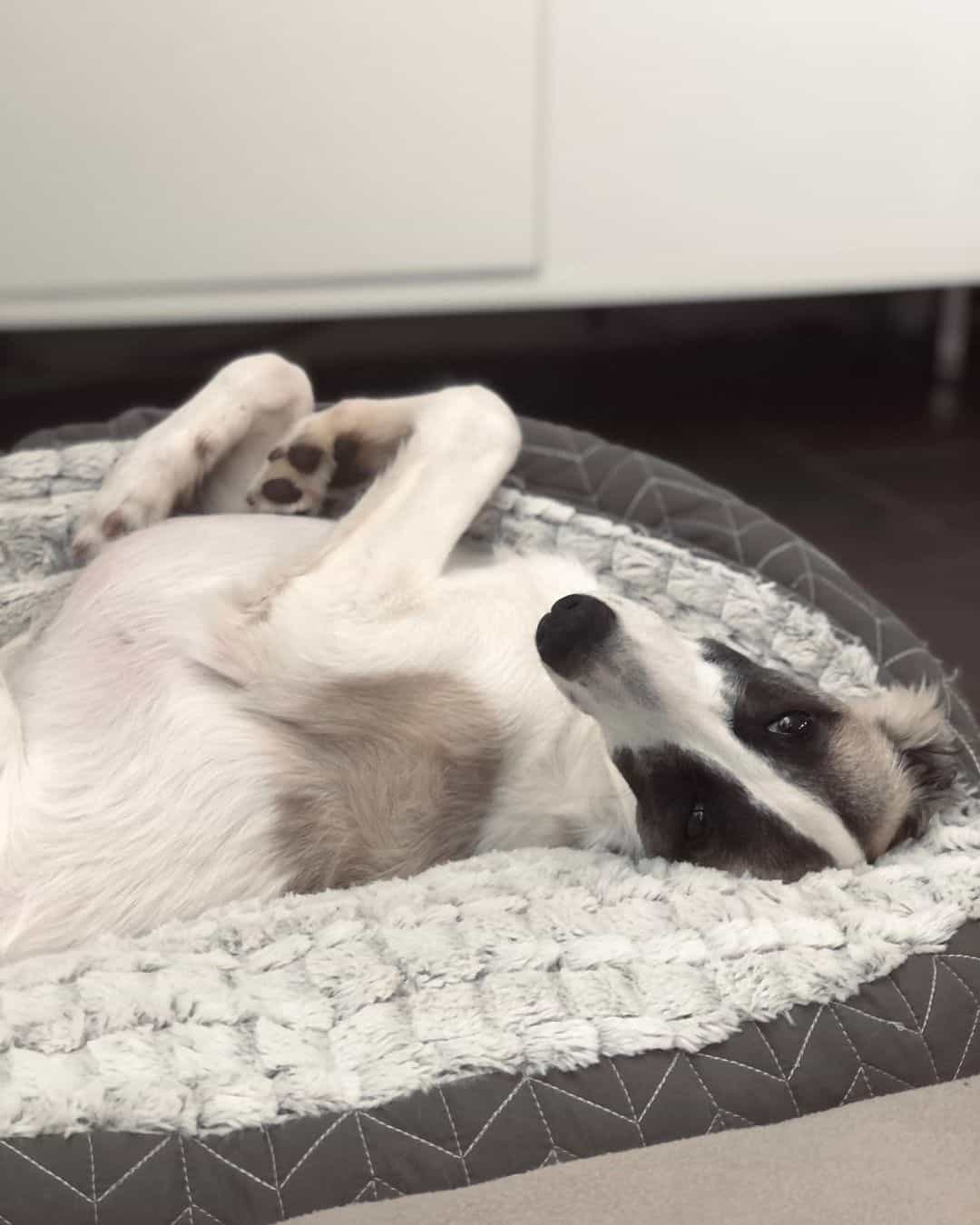
The Long Haired Whippet gets along well with different dogs, however cats are, for them, excellent for pursuing, and you definitely don’t want that stress in your life. Thus, dogs are good. Cats = most likely not.
These dogs enjoy company and human interaction (including children!), and provided they aren’t in a busy, noisy environment where they could feel overwhelmed, they’ll be OK with the company.
They are content to spend time with you and require your company for the majority of the day. You will need to make arrangements for a friend to drop by for some fun if you anticipate being away.
Although whippets enjoy having a fenced yard to run around in, apartment dwellers shouldn’t rule out getting one of these dogs. They are wonderful companions and are suitable for apartment living as long as they have lots of exercise and care.
A Whippet would thrive in a home with lots of opportunities for exercise and lots of plush beds, pillows, and blankets to curl up in and snooze afterward.
As long as you can provide them plenty of opportunities to gallop around, you don’t need to lead an extremely active lifestyle; a moderate to higher level lifestyle is completely fine.
A Whippet must live indoors because there isn’t much meat on their bones, which makes them susceptible to getting chilly.
If you want to raise a Whippet, be prepared to invest in a sizable wardrobe of dog sweaters, raincoats, and warm jackets because they are quite fussy about the temperature in general.
Final Word
Whippets do shed, but it’s not as much as other dogs. Your couches actually just need to be brushed once a week to keep them clear of pet hair.
Whippets don’t bark much. They are not a vocal breed; however, they are known to let you know when the doorbell is rung. They are actually fairly calm dogs.
The Long Haired Whippet is an excellent pet for both families and singles. They thrive in a home where they can get lots of exercise and still be allowed to be sluggish and spread out on the sofa because they enjoy being near people.
They are wonderful with children, but because of their intense drive to chase, they require a home without cats.
Whippets are intelligent dogs, but they can be a little resistant to obedience training. They pick up abilities rapidly but were designed for hunting independently of humans.
Despite their independence, they are highly adept at picking up simple commands and manners. Gentle guidance and lots of encouragement are the keys to their learning.
